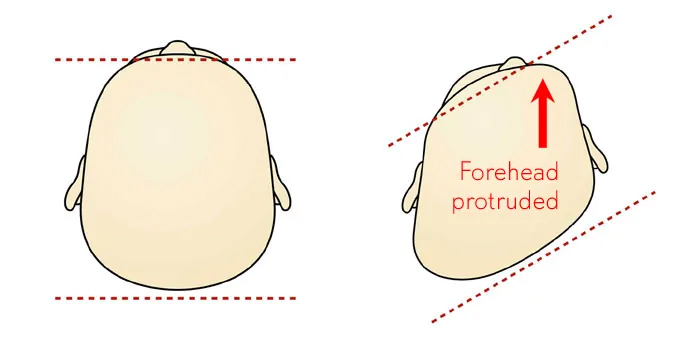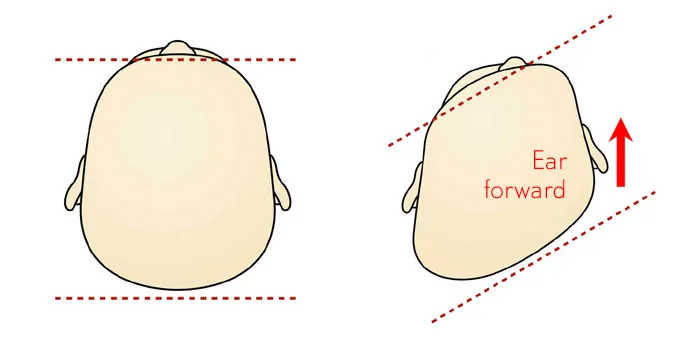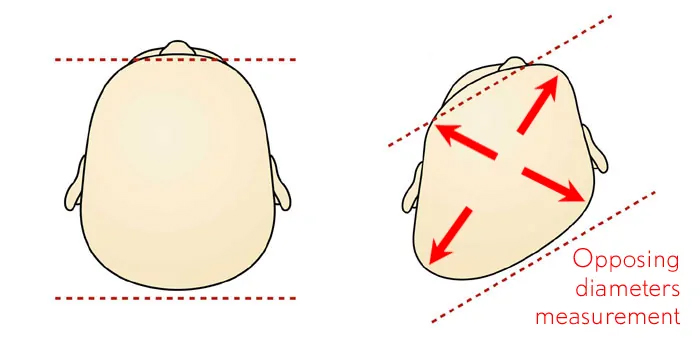A baby’s preferred head position when sleeping can be a big factor when managing a baby with an acquired flat head or deformational plagiocephaly or brachycephaly. In many instances, a fixed head position when sleeping is how the flat skull problem comes about in the first place. Repositioning a baby’s head position when sleeping is an important part of avoiding or reducing head flattening in an infant but this can be difficult if a baby cannot comfortably or fully turn their head to both sides and maintain that position for extended periods.
Our Chiropractor Richard has managed hundreds of babies with neck turning restriction and a great many with plagiocephaly and flat head problems so has a great deal of experience in this area. All new patient visits are obligation free so if a parent simply wishes to have their baby assessed and have some questions answered that is fine.
There are a number of types and causes of plagiocephaly and our Chiropractor is equipped to determine which type is present and appropriate treatment, including referral.
Once the cause behind a baby’s skull flattening has been reduced or removed where possible i.e., through re-positioning, exercises, stretching, time or treatment, common questions asked by parents include “will the flat spot go away?”, “how much of it will resolve?” and “how long will it take?”
There are no simple answers to these questions as each case is unique, but I below are some of the factors that may influence the outcome.
Most babies with an acquired flattening of their skull (deformational plagiocephaly or brachycephaly) will improve over time. The more severe the deformation, the less likely the flattening will be completely resolved. Mild cases and when the cause of the flattening is addressed early on (i.e. within 1-2 months) are more likely to resolve completely. Moderate and severe cases can still improve with time but may be less likely to resolve completely.
There are several ways to grade the magnitude of a baby plagiocephaly case and monitor its progress over time. This is best done by a health professional with experience in this area. Some of the things a parent can look for include:
Does the infant’s forehead protrude forward on the affected side, and if so is it visible from front-on or only when viewed from above? Deformational plagiocephaly is typically less severe if only visible from above.



The quicker a parent can identify and address the cause behind the skull flattening the better. It is common for parents to first notice deformational plagiocephaly around 2 months of age but it is likely in many cases that the flattening process started weeks before then. A baby’s skull is heavy and cranial bones are most malleable in the early months of life (this is one of the reasons the problem tends to occur in the first place). As a result, the best window for short term head shape recovery is in the first 6-12 months of life.
An average baby’s head circumference will grow by 11cm (31%) in their first year (much of this occurs in the first 7 months). This rapid growth in brain and skull size is likely to assist with rounding out the head shape. By comparison, in the second year of life their head will gain on average only 2.25cms (5%). After that the head circumference will typically add only 0.5cm per year till maturity.
As the child’s skull grows and matures with age, there is still scope for improvement in head shape by changes in bone structure and shape. The rate of change here is slower but the bones of the skull will change shape and size a great deal in the years that follow. Just think of how much a child’s face, nose, jaw and eye sockets will change as they reach school age, high school age and eventually adulthood.
If you have any questions on the topic of helping babies with a flat head, plagiocephaly or brachycephaly please contact us at our Unley Adelaide office anytime.
© 2024 - Sure Start Health